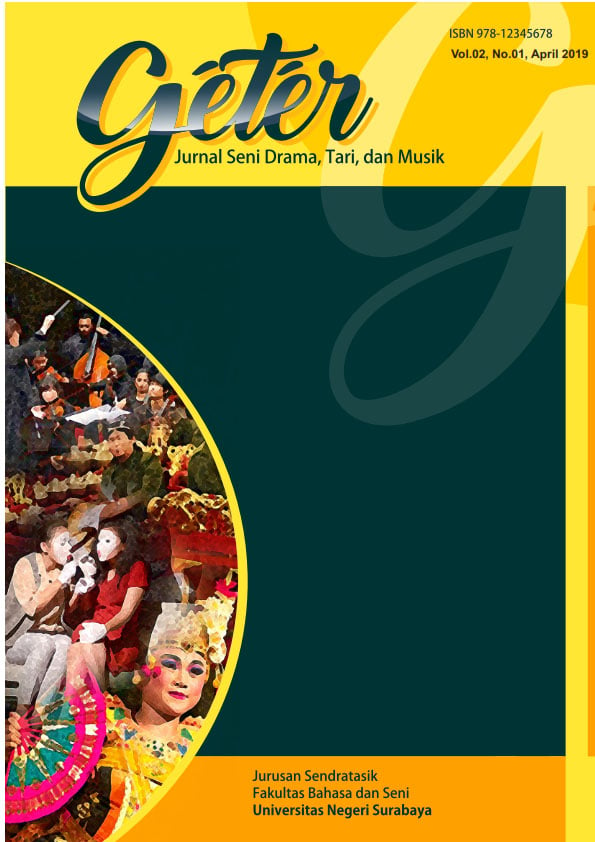TARI REMO (NGREMONG): SEBUAH ANALISIS TEORI SEMIOTIKA ROLAND BARTHES TENTANG MAKNA DENOTASI DAN KONOTASI DALAM TARI REMO (NGREMONG)
Main Article Content
Abstract
Semiotik aims to look for the production and consumption of meaning that is on the mark. In this case the sign system can be used as one of the frame of mind that helps one in interpreting a meaning. One example is the study of semiotics. Semiotics represents a wide range of field studies, ranging from art, literature, anthropology, mass media, and so on. Semiotic study is a way or method to analyze and give meanings to the symbols contained in a symbol of message or text. The substance of dance is motion. The purpose of motion here, not the motion of everyday man, but the motion in a certain sense and process so that it changes from the natural form. Remo dance is one of the traditional dance form of East Java which is expressed from the vibration of soul and emotion of East Java society. Remo dance movement is obtained from the vibrations of the soul and emotions of East Java. The main characteristic of dance Remo is a dynamic dance movement. In this case the motion of remo dance will be analyzed using Barthes' semiotic theory.
Keywords: semiotics, signs, dance, motion, remo.
Article Details
References
Aart Van Zoest, 1993/ Semiotika: Tentang Tanda, Cara Kerja, Apa yang Kita Lakukan dengannya.
Aji, Bimo Kusumo. Sejarah Tari Remo. (http://infobimo.blogspot.co.id/2014/11/sejarah-tari-remo.html), diakses pada tanggal 2 Januari 2015
Culler, Jonathan. 2002. Bathes, Seri Pengantar Singkat (terjemahan ruslani). Yogyakarta: Jendela.
Deledalle, Gerrard. 2000. Charles S. Pierces Philosophy of Sign: Essay in Comparative Semiotic. Bloomingtoon dan Indianapolis: Indiana University Press
Editor. Tari Remo (http://kebudayaanindonesia.net/kebudayaan/901/tari-remo), diakses pada 2 Januari 2015
Hadi, Sumandiyo. 2005. Sosiologi Tari. Yogyakarta: Pustaka Book Publisher.
Hartono, Agustinus. 2010. Imaji/ Musik/ Teks Rolland Barthes. Yogyakarta: Jalasutra
Jazuli. 2008. Pendidikan Seni Budaya Suplemen Pembelajaran Seni Tari. Semarang: UNNES PRESS.
Kaelan. 2009. Filsafat Bahasa dan Semiotika dan Hermeneutika. Yogyakarta: Paradigma.
Kristi, Rinthania. Keunikan tari Remo (http://rinthania-kristi-fisip12.web.unair.ac.id/artikel_detail-59078-Umum-MAKALAH), diakses pada tanggal 2 Januari 2016
Kurniawan. 2001. Semiologi Roland Bathes. Magelang: Indonesiatera.
Pradopo, dkk, Metodologi Penelitian Sastra, PT. Hanindita Graha Widya, Yogyakarta, 2001.
Sudjiman dan van Zoest. 1992. Serba-serbi semiotika. Jakarta : Gramedia Pustaka Utama
Sumandiyo, Hadi. 2007. Kajian Tari Teks Dan Konteks. Pustaka Book Publisher:
Yogyakarta.
____, Sumandiyo. 2007. Kajian Tari. Yogyakarta: Pustaka Book Publisher.

